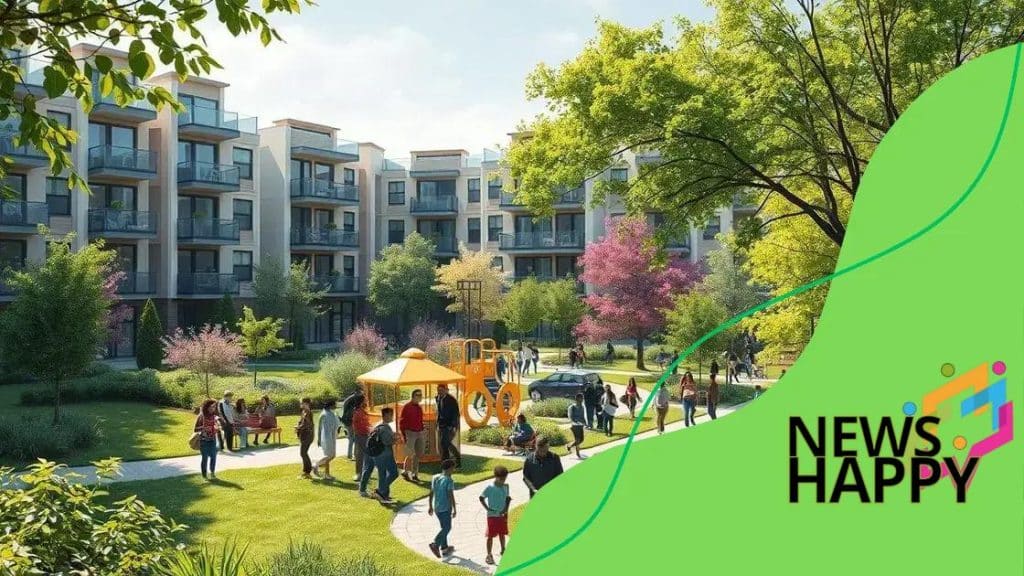Federal funding for low-income housing projects in urban areas

Anúncios
Federal funding for low-income housing projects is essential for addressing housing shortages, improving community infrastructure, and enhancing the quality of life for low-income families.
Federal funding for low-income housing projects in urban areas plays a crucial role in addressing housing shortages. Ever wondered how these initiatives shape communities? Let’s dive into their significance.
Anúncios
Understanding federal funding mechanisms
Understanding federal funding mechanisms is vital for grasping how low-income housing projects receive support. These mechanisms involve various processes that allocate financial resources to local governments and organizations. Let’s explore these vital systems further.
How Federal Funding Works
Federal funding comes through designated programs aimed at specific needs, such as low-income housing. The government distributes these funds based on criteria that prioritize communities with the most pressing needs. Local agencies often apply for these funds to finance their projects.
Key Programs for Housing Funding
- Community Development Block Grants (CDBG): Designed to provide funds for housing, community facilities, and infrastructure improvements.
- HOME Investment Partnerships Program: Aimed at creating affordable housing for low-income families.
- Low-Income Housing Tax Credit (LIHTC): Offers tax incentives to developers for building affordable rental housing.
These programs play a crucial role in shaping urban landscapes. They not only help create more housing options but also stimulate local economies. Understanding the eligibility and application processes can significantly enhance the chances of securing these funds.
Anúncios
Moreover, innovative financing methods, such as public-private partnerships, are gaining traction. These collaborations allow for shared investment in housing projects, maximizing the potential of federal resources while fostering community engagement.
Funding Application Process
Typically, cities or organizations interested in federal funding must follow a structured application process. This process often includes project proposals outlining the anticipated impact on low-income housing. Applications are reviewed based on established criteria, ensuring that those most in need receive attention.
Additionally, applicants can participate in workshops or training sessions offered by federal agencies to improve their understanding. These resources provide valuable insights on best practices for creating competitive proposals. By leveraging these tools, organizations can effectively navigate the complex landscape of federal funding.
The impact of funding on urban development
The impact of funding on urban development is significant, as it shapes the future of cities and communities. When federal funding is allocated for low-income housing, it provides essential resources that can lead to transformative changes in urban areas.
Enhancing Community Infrastructure
Funding allows for the improvement of critical infrastructure within communities. When low-income housing projects receive federal support, cities can invest in better roads, parks, and public transport. These enhancements not only make neighborhoods more livable but also attract new residents and businesses.
Moreover, improved infrastructure leads to increased safety and accessibility. With well-planned roads and public spaces, residents can navigate their communities more easily. This encourages social interaction and creates a sense of belonging among inhabitants.
Boosting Local Economies
- Job creation: Construction projects funded by the government provide employment opportunities for local workers.
- Business growth: New housing attracts businesses that cater to residents, fostering economic expansion.
- Increased property values: As neighborhoods improve, property values rise, benefiting existing homeowners.
Local economies flourish with the injection of federal funds into low-income housing projects. Jobs are created not only in construction but also in the service industries that support the growing population. As businesses establish themselves in these revitalized areas, they contribute further to economic growth.
Investing in low-income housing also helps to alleviate poverty. By providing affordable living options, federal funding enables families to thrive, focusing on education and health rather than worrying about housing stability. This shift can lead to long-term benefits, such as healthier communities and improved quality of life.
The Ripple Effect of Development
Moreover, the positive effects of funding for low-income housing extend beyond just the immediate areas. When urban development is enhanced through federal support, the benefits can ripple through neighboring regions. Improved housing, infrastructure, and economic activity can lead to increased tourism and investment from outside the community.
Additionally, successful low-income housing projects serve as models for other locales. They demonstrate how strategic funding can lead to effective urban development initiatives, inspiring similar efforts in various communities. These collaborative models can foster stronger ties between governments, non-profits, and private sectors, all working towards a common goal of improved living conditions.
Challenges in accessing federal funds

Challenges in accessing federal funds pose significant barriers for many organizations and communities aiming to improve low-income housing. Despite the availability of funding, various obstacles can complicate the process.
Complex Application Processes
One of the main challenges is the complex application process. Many organizations may lack experience in navigating federal guidelines and requirements. This complexity can lead to missed opportunities, as potential applicants may not fully understand what is needed to apply successfully.
- Detailed documentation: Applications often require extensive documentation, making it difficult for smaller organizations to comply.
- Strict timelines: Funding opportunities usually have tight deadlines, which can hinder organizations that may need more time to prepare.
- Competitive nature: With many applicants vying for limited funds, standing out becomes a major challenge.
Additionally, a lack of technical assistance can leave smaller organizations feeling overwhelmed. Without guidance, they may not know where to start, reducing their chances of securing necessary funding.
Disparities Among Applicants
Furthermore, there are notable disparities in access to funding. Larger organizations often have dedicated staff who specialize in grant writing. In contrast, community groups or smaller nonprofits may not have these resources, creating an uneven playing field.
These disparities can further entrench existing inequalities, as communities in need may miss out on funds simply because they lack the capacity to apply. Such inequities call for more equitable systems that support all potential applicants, regardless of size or experience.
Language barriers pose another serious issue for many communities. Non-native English speakers may struggle with understanding the application requirements, leading to fewer successful applications from diverse populations. This situation highlights the need for allocation and outreach efforts that consider the various languages and cultures present in communities deemed eligible for funding.
Lack of Awareness and Outreach
Lastly, many organizations simply might not be aware of the funding opportunities that exist. Insufficient outreach and communication from federal agencies can leave potential applicants in the dark. Improved communication strategies are essential to ensure that all eligible organizations are informed about available resources.
To combat these challenges, training programs and workshops could be established to help demystify the application process and equip organizations with the tools they need to succeed. By addressing these barriers, we can create a more inclusive landscape where federal funds can effectively reach the communities that need them most.
Successful projects funded by the government
Successful projects funded by the government demonstrate the positive impact of federal funding on low-income housing. These projects not only provide affordable living options but also contribute to community growth and development.
Case Study: The XYZ Housing Development
One noteworthy example is the XYZ Housing Development, which received significant federal funding. This project transformed a previously underdeveloped area into a thriving community. With modern apartments and essential services nearby, it has greatly improved the standard of living for many residents.
- Increased Accessibility: Residents have easy access to public transit and local businesses.
- Community Spaces: The development includes parks and recreational areas, promoting community engagement.
- Job Opportunities: Construction created jobs, and new businesses have opened to serve the influx of residents.
As a result, this project is not only a housing success but also an economic driving force.
Innovative Solutions in Urban Areas
Another successful initiative is the Green Roofs Project, which integrates green spaces in urban housing. Funded through federal grants, this project supports environmental sustainability while providing recreational areas for residents. It showcases how federal funding can lead to innovative solutions that tackle multiple urban challenges simultaneously.
Green roofs help reduce heat in cities, improve air quality, and promote biodiversity. This project has inspired similar initiatives in other urban areas, proving that effective use of federal funds can lead to widespread improvements.
Community-Driven Approaches
Moreover, successful projects often involve community participation. Programs like the Community Land Trust have gained popularity, allowing residents to have a stake in the development process. With federal support, these trusts empower communities to create their own affordable housing solutions.
Through local involvement, these projects foster a sense of ownership and responsibility. When residents participate in decision-making, they are more likely to invest in maintaining and improving their community.
Making a Difference
Successful government-funded projects highlight the importance of collaboration among various stakeholders. By combining resources from local governments, non-profits, and community organizations, these initiatives can effectively address housing shortages and improve living conditions. They provide clear examples of how targeted funding can transform communities and create sustainable solutions for low-income housing.
Future of low-income housing funding
The future of low-income housing funding is poised for significant changes as communities adapt to ongoing challenges. With rising housing costs and increasing urban populations, innovative funding methods are essential to meet the needs of low-income families.
Emerging Trends in Funding
One emerging trend is the shift towards public-private partnerships. These collaborations between government entities and private developers can pool resources and share risks. By leveraging private investments alongside public funding, partnerships can increase housing availability and lower costs for residents.
- Access to additional capital: Private partners can provide the necessary funding to develop larger projects.
- Innovation: Private companies may introduce new technologies and efficient building practices.
- Shared responsibility: Both sectors benefit from the partnership, ensuring continued support and interest in the project.
This approach not only enhances funding opportunities but also fosters sustainable development in urban areas.
Government Policy Changes
As policies evolve, new legislation may provide more resources for low-income housing. Upcoming reforms could focus on increasing tax incentives for developers to create affordable units. Enhanced funding programs can also support inclusive zoning, which promotes mixed-income developments.
These measures aim to create a more balanced housing market where low-income families are not excluded. Keeping an eye on policy shifts can help stakeholders adapt to changing landscapes and better compete for available funds.
Community Engagement and Activism
Community engagement plays a crucial role in the future of low-income housing funding. Local organizations and residents must advocate for their needs, ensuring that funding aligns with community priorities. Grassroots campaigns can raise awareness and influence decision-makers by highlighting the importance of affordable housing.
Successful advocacy can lead to increased funding allocations that reflect the unique requirements of each community. This engagement encourages transparency and accountability, helping to shape a housing landscape that supports everyone.
Technology and Data-Driven Solutions
The integration of technology will also shape the future of housing funding. Utilizing data analytics can help identify the most effective funding strategies. Stakeholders can gain insights into community needs and trends, allowing for data-driven decisions in housing development.
For example, geographic information systems (GIS) can map areas in need of affordable housing, guiding fund distribution where it is most needed. As technology continues to advance, housing organizations can better analyze outcomes and improve funding allocations.
FAQ – Frequently Asked Questions about Federal Funding for Low-Income Housing Projects
What are public-private partnerships in housing funding?
Public-private partnerships involve collaboration between government entities and private developers to pool resources and share risks, enhancing funding opportunities.
How can communities advocate for low-income housing funding?
Communities can engage in advocacy by organizing campaigns, attending local meetings, and expressing their housing needs to decision-makers.
What role does technology play in housing funding?
Technology helps identify funding strategies through data analytics, enabling stakeholders to make informed decisions based on community needs.
What future trends can we expect in low-income housing funding?
Future trends may include increased public-private partnerships, enhanced government policies, and greater community engagement to address housing shortages effectively.





